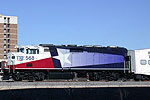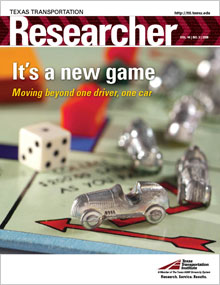Passenger rail could be making a substantial comeback

Passenger rail was the best way to travel long distances 100 years ago. In the 20th and early 21st centuries, rail has been the exception rather than the rule. But in the wake of rising gas prices and reduced mobility, transportation planners are now looking at this venerable travel mode in a completely new light.
After the development of the highway system, automobile travel exploded while rail and other transit ridership fell. Texas congestion problems were solved by building new roads or expanding the ones we had. But since at least the mid-1990s, many Texas cities are running out of real estate for highway expansion, and funding for new road construction is limited. Combine that with an ever-increasing population, and you get an estimated 350,000 additional passenger vehicles on Texas roads each year. That’s a recipe for a crisis—imagine what the traffic will be like after we double our population over the next 30 to 40 years.
To be fair, the recent high cost of gasoline has relieved some of the pressure as a small percentage of motorists have turned to other options such as public transit, telecommuting, carpooling and high-occupancy vehicle (HOV) lanes. However, experts agree that any congestion relief will be short lived because population increases will more than fill in the gaps. Most believe that the solution lies in providing alternatives, including passenger rail.
“There has been a greater interest nationally in commuter and intercity rail,” according to Jeff Arndt, a research scientist with the Transit Mobility Program at the Texas Transportation Institute (TTI). “It’s an alternative that should be considered. Not because it will mean automatic congestion relief, but because we have to accommodate travel demand using as many options as possible…buses, carpools, HOV lanes, managed lanes, rail, even alternative work weeks and telecommuting, along with the traditional solution of expanding and building new roads.”
Two definitions are crucial in understanding the main types of passenger rail. “Commuter rail” is considered medium-haul rail passenger service operating in and between metropolitan and suburban areas, running mostly during morning and evening peak periods. “Intercity rail” is express train passenger services that cover longer distances than commuter trains. The Trinity Railway Express is an example of commuter rail, while Amtrak service between Dallas/Fort Worth and San Antonio is an example of intercity rail.
Arndt recently completed a light/commuter rail project for the Texas Department of Transportation (TxDOT), the results of which will be published this year. The research effort examines two areas: rail projects around the country focusing on the roles played by departments of transportation (DOTs) and how rail projects achieve the five strategic goals of TxDOT.
“TxDOT has traditionally played a catalyst role in the consideration of commuter rail projects for Texas by funding feasibility studies,” Arndt says. “This project looks at additional roles that TxDOT may wish to undertake.”
In an August speech at the Texas Transportation Summit in Irving, Texas, TxDOT Executive Director Amadeo Saenz told attendees that the state has partnered with Amtrak to study the feasibility of providing additional intercity passenger rail service between Austin and San Antonio.
“Amtrak already operates one train in the corridor—the Texas Eagle—which travels between San Antonio and Chicago,” Saenz said. “TxDOT wants to provide more reliable service in the corridor while allowing passenger and freight trains to operate on the same route.”
Saenz announced that TxDOT recently applied for $3.5 million in federal funding for an Amtrak rerouting project in Fort Worth. “The federal government is looking for states to play a larger role in improving intercity passenger rail systems and networks. And they’ve provided some—but not all—of the funding needed toward that end,” he said.
So…how do we create an intercity passenger rail system? How much will it cost and how do we pay for it? Can passenger rail and freight rail interact? In an earlier 2005 project, TTI sought to answer these and other questions. That effort analyzed four states: California, North Carolina, Pennsylvania and Virginia. It also looked at one multi-state corridor, the Pacific Northwest Rail Corridor of Washington and Oregon.
“Some of the rail programs were completely state owned; others were partnerships with Amtrak,” says Curtis Morgan, assistant research scientist and program manager of TTI’s Multimodal Freight Transportation Program. “Some had multiple routes of higher speed corridors connecting the major urban areas of the state, while others were partnerships between freight railroads and state DOTs.”
Researchers examined the numerous funding methods of those rail projects, including state bond and general funds, local and federal funds, and a combination of monies from Amtrak and private freight railroad company sources. Researchers offered numerous recommendations for TxDOT to consider when making the decisions regarding investment in intercity passenger rail.
TxDOT has also funded an ongoing research project, led by Morgan, that is evaluating future intercity transit needs throughout Texas where passenger rail or express bus services may one day be realized.
“Implementing intercity passenger rail is obviously a huge undertaking,” Morgan says. “Funding is perhaps the biggest concern, but developing the system without impacting freight rail lines, we think, is an important element. It will take a lot of planning and cooperation, but in my view, it’s essential and worth pursuing.”
